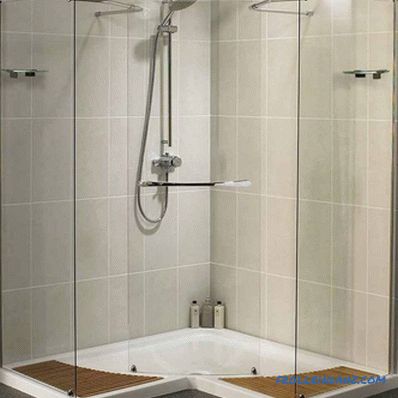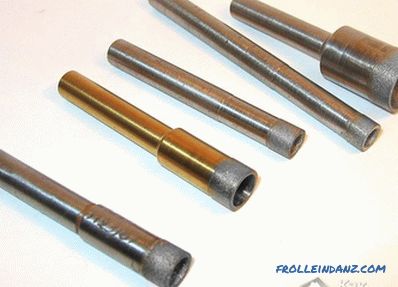Not so long ago, many people did not understand why they needed to warm the walls of their homes. Now, with the rising cost of fuel, there are not too many people who do not want to reduce their heating costs. Since the question of how to make wall insulation is very relevant, we will consider several options for performing this task.
- Construction of thermal insulation materials.
- Laying insulation between the walls during the construction of the structure.
- Outdoor insulation.
- Internal warming.
Let us dwell on each method, describing the technology in detail, possibly affecting the advantages and disadvantages.
We build from heat-insulating materials
 Building a house from aerated concrete
Building a house from aerated concrete
In principle, it is possible to make a warm wall from the available ordinary materials, only for this it should be 1 meter thick! In addition to the increased consumption of building materials, it would still be necessary to fork out for a more powerful foundation for such a heavy structure. Although it used to be built like this, now these technologies have remained unclaimed due to the appearance on the market of a new type of building material - thermal insulation. These are:
- aerated concrete (twin blocks);
- foam concrete;
- arbolite;
- clay blocks;
- concrete based on claydite.
 In a wooden house in winter, the heat is
In a wooden house in winter, the heat is
Wooden houses also have good thermal insulation properties, but in this article about them will not be told.
You can learn more about the characteristics of a particular material listed by clicking on the appropriate link.
Each of these materials has a different thermal conductivity, so the thickness of the walls is selected individually, taking into account the region in which the house will be built.
Laying insulation between walls during construction
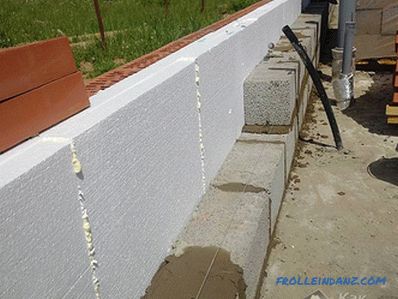 Laying walls with insulation
Laying walls with insulation
If Since the house is only planned to be built, then we can consider the option of internal wall insulation. In this case, materials that do not differ in high rates of heat saving are used. As a rule, these are:
- bricks;
- cinder blocks;
- concrete;
- stone (shell rock, for example);
- facing brick is used for exterior decoration.
At the design stage of the foundation, the width of the wall is taken into account along with the insulation.
Insulation must be moisture resistant, therefore, foam, fiberglass or penoizol is used.
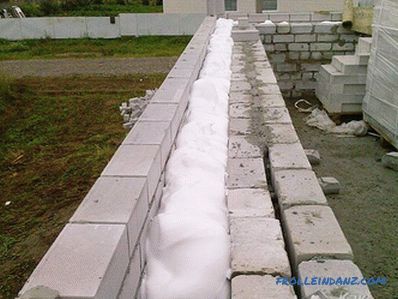 The use of penoisol
The use of penoisol
We will not describe the construction process, since this is the topic of another article, but in in general, we can say that there are several options for the placement of insulation:
- At the same time, the walls (bearing and facing) are erected, and insulation is immediately placed between them.
- 2 walls are erected and a void remains between them, which is filled with bulk insulation material or concrete on the basis of expanded clay. Someone decides to leave the air gap as a heater or blow Penoizol there.
- A building is being erected, walls are insulated and sheathed with facing brick.
The outer part of the wall can be made of simple brick, and then it can be plastered and revetted with a decorative stone.
Outdoor insulation
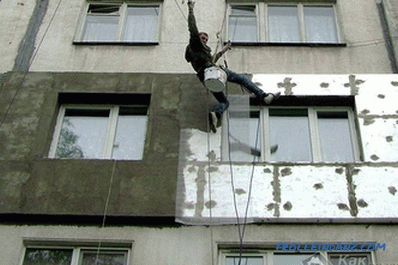 Outdoor insulation of the house with foam
Outdoor insulation of the house with foam
In the previous the subtitle has already been mentioned about the weatherization of an already constructed building, but in the event that the foundation is not designed for additional load, then without its strengthening, facing brick cannot be used. In this case, the insulation is puttied or a ventilated facade is installed. If you carry out cladding facade thermopanels, then the finishing will not be needed.
The process of warming
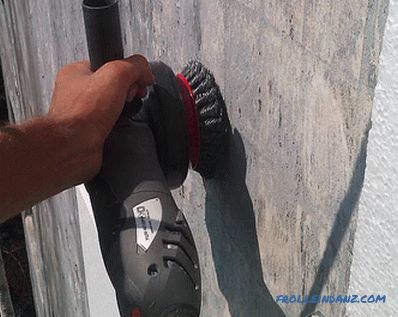 Preparing the wall for facade insulation with polystyrene foam
Preparing the wall for facade insulation with polystyrene foam
Walls need to be prepared and if they are uneven, they will have to be plastered, otherwise the consumption of expensive glue will be very large. In some cases, foundation insulation may be required.
We can not forget about the base - it also needs to be warmed.
Polyfoam or mineral wool should be fixed on the wall, protected from precipitation and other external influences. In more detail with the technology of insulation of these materials can be found by reading the article:
- How to warm the walls with foam.
- Warming of the facade with foam plastic.
- How to insulate the facade of mineral water.
Internal insulation
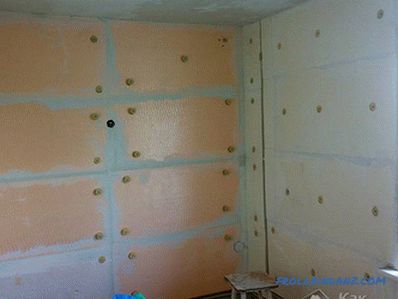 Wall insulation from inside
Wall insulation from inside
When it comes to about the warming of the walls of the frame structure, here everything is extremely simple, as the insulating material is mounted inside the frame and sheathed. In more details the technology of warming is described here.
It is quite another thing when you need to insulate the walls in an apartment.Immediately it should be noted that for any other houses, except the frame, such insulation is performed only as a last resort, if it is impossible to perform outdoor. There are only a few good reasons for this:
- The house is of historical value, and no work can be done on its facade.
- Outside, it is impossible to get close to the wall that needs to be warmed up or it will not be possible to fix insulation on it (for example, there is a deformation seam between buildings, an elevator shaft or other unheated room behind the wall).
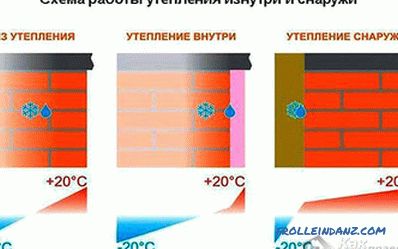 Features of wall insulation from inside
Features of wall insulation from inside
Why do we speak about the internal insulation of an apartment as undesirable ? To make it clearer, consider what will happen in the winter.
- If the wall is insulated from the outside, then a layer of insulation protects it from the cold, and it remains warm, heated by the positive temperature of the heated room.
- With internal insulation, the outer part of the wall is not protected by anything, but now it is no longer heated from the inside, as a result of which the dew point shifts to the place of its contact with the insulation. A large amount of moisture causes mold. In addition, freezing and thawing of the wall leads to its premature destruction.
The statistics are disappointing, but if there is no other way out, you will have to stop on this method of insulation - the main thing is to do everything correctly.
The positive side of the apartment’s internal insulation is that work can be done in any weather and there is no need to involve industrial climbers.
- A vapor barrier must be placed between the wall and the insulation.
- You need to worry about the ventilation device.
- If the dimensions of the room permit, then an air gap must be left between the wall and the thermal insulation material. For this purpose, the lathing is made of an aluminum profile and is not installed close to the wall, but the insulation is attached to it.
A few square meters will be lost, but such a sacrifice is justified.
We considered the main ways of wall insulation and sincerely hope that you will spend the winter in a warm and dry room.
Video
This video is a step-by-step instruction on external wall insulation:
Watch a video showing how to make brickwork with insulation:



